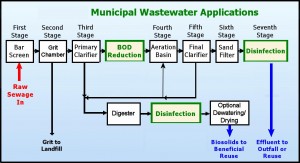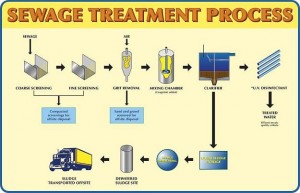

Sewage Treatment Process
Waste Water Treatment Process
1.Physical Water Treatment Operations
In the physical unit operations physical forces are utilized in some water treatment units for the removal of solid contaminants. The physical unit water treatment operations are:
- water treatment Screening
- water treatment Mixing
- Water Treatment Flocculation
- Water Treatment Sedimentation
- water treatment Flotation
- water Treatment Filtration

2 Chemical Water treatment Processes
In chemical unit Water Treatment process the removal or conversion of some solids, is brought about by the addition of chemicals or by other reactions. Common examples of chemical unit water treatment process are:
- Gas transfer by aeration,
- Adsorption, and
- Disinfection
3 Biological water treatment Processes
In biological water treatment processes the removal or conversion of organic solids is brought about by the biological activities. They remove colloidal or dissolved bio-degradable organic substances in wastewater. Organic substances are converted into gases that can escape to the atmosphere and as biological cell tissues that can be removed by settling.
STAGES OF SEWAGE TREATMENT
Types and nature of solids present in wastewater and unit operations/processes used for their removal
| Type of solids | Nature of solids | Unit Operations/Process used for removal |
| Floating | Coarse Organic and inorganic | Coarse screen |
| Fine organic and inorganic solids and algae | Microscreens | |
| Suspended Solids | Settleble inorganic | Grit chamber |
| Settleble organic | Primary sedimentation tank | |
| Non settleble organic | Biological process followed by secondary sedimentation tank | |
| Dissolved solids | Organic | Biological process |
| Inorganic | Reverse OsmosisRoot zone treatment with certain type of trees and aquatic plants |
The wastewater treatment is achieved in three stages; primary, secondary and tertiary treatments.. Some of the unit operations and processes are included in each stage of treatment. The process flow diagram of a typical wastewater treatment plant is furnished in Table
1 Primary Sewage Treatment
The first stage of sewage treatment is known as primary treatment which also includes certain preliminary operations such as flow equalization, communication (or grinding), grease removal, flow measurement, etc. The unit operations in primary treatment are screening to remove larger floating objects, grit removal for removing inert sand and inorganic particles, and settling for removing settleable suspended organic solids. The main purpose of the primary treatment is to produce a generally homogeneous liquid capable of being treated biologically and a sludge that can be separately treated or processed.
2 Secondary sewage Treatment
The next stage of sewage water treatment is secondary treatment, which is designed to remove soluble organics from the wastewater. Secondary treatment consists of a biological process and secondary settling. Secondary treatment is designed to substantially degrade the biological content of the sewage such as derived from human waste, food waste, soaps and detergent.
3 Types of Biological Treatment based on Process
There are two types of biological water treatment process; aerobic and anaerobic. Aerobic process means that dissolved oxygen (DO) is present for the microbes for respiration. Anaerobic process means that the process proceeds in the absence of DO.
The effluent from primary water treatment units is further treated generally using aerobic biological processes. For these processes to be effective, the microorganisms require both dissolved oxygen and a substrate on which to live. Oxygen can be supplied either through natural process or artificial mechanical means. In both cases, the bacteria and protozoa consume biodegradable soluble organic contaminants and bind much of the less soluble fractions into floc particles. The oxidization of organic substances can be achieved by anaerobic process also by anaerobic organisms, which don’t need DO. They take their oxygen requirement from complex organic substances, such as sulphate (SO4), phosphate (PO4), etc.
The end-products of aerobic and anaerobic processes are different. Under aerobic conditions, if completely oxidized, organic matter is transformed into non-hazardous products such as CO2 and H2O and cell tissues. But an anaerobic process, apart from CO2 and H20 and cell tissues, can also produce methane (CH,), which is explosive, and ammonia (NH3) and hydrogen sulfide (H2S), which are toxic. Some materials are better degraded under anaerobic conditions than under aerobic conditions. In some cases, the combination of anaerobic and aerobic systems in a series provides better and more economical treatment than either system could alone provide.
Classification of biological sewage treatment based on growth system
Biological sewage treatment systems are classified into systems: (a) attached growth system, and (b) suspended growth systems. Aerobic and anaerobic biological systems are available in both attached and suspended growth configurations. Examples are as follows:
- Aerobic attached growth systems: trickling filter and RBC;
- Aerobic suspended growth systems: activated sludge process, aerated lagoon, waste stabilization ponds etc.
- Anaerobic attached growth systems: anaerobic filters and upflow anaerobic sludge blanket units.
- Anaerobic suspended growth systems: septic tanks and anaerobic ponds.
- The final step in the secondary treatment stage is to settle out the biomass as biological floc or filter material generated during biological treatment and produce sewage water containing very low levels of organic material and suspended matter. This settled biomass or secondary sludge is then piped to sludge-management systems, while the effluent from SST is disposed.
Sludge treatment and disposal
The sludge accumulated in a wastewater treatment process must be treated and disposed of in a safe and effective manner. The purpose of sludge digestion is to reduce the amount of organic matter and the number of disease-causing microorganisms present in the solids. The most common treatment options include anaerobic digestion, aerobic digestion, and composting. The choice of a wastewater sludge treatment method depends on the amount of solids generated and other site- specific conditions. However, in general, composting is most often applied to smaller-scale applications followed by aerobic digestion and then lastly anaerobic digestion for the larger-scale municipal applications.
4 DISINFECTION
The purpose of disinfection in the treatment of wastewater is to substantially reduce the number of living organisms in the water to be discharged back into the environment. The effectiveness of disinfection depends on the quality of the water being treated (e.g., TSS, pH, etc.), the type of disinfection being used, the disinfectant dosage (concentration and time), and other environmental variables. Turbid water will be treated less successfully since solid matter can shield organisms, especially from ultraviolet light or if contact time is low. Generally, short contact times, low doses and high flows are against effective disinfection. Common methods of disinfection include use of ozone, chlorine, or UV light. Chloramine, which is used for drinking water, is not used in waste water treatment because of its persistence. Disinfection follows secondary clarification in most treatment plants or after tertiary treatment when the wastewater reclamation and reuse is contemplated. Disinfection is normally accomplished with chlorine. Due to the potential environmental impact of chlorine, most plants now dechlorinate wastewater effluents before discharge.
5 TERTIARY SEWAGE TREATMENT
Third stage waste water treatment is referred to as tertiary sewage treatment or advanced waste water treatment. More commonly used advanced systems are adsorption to activated carbon, filtration through sand and other media, ion exchange, various membrane processes, nitrification-denitrification, coagulation-flocculation, and micro-screening.
20 Responses to “Sewage Treatment Process”
Leave a Reply







 LIKE TO GET UPDATES
LIKE TO GET UPDATES  TO GET EXPERT GUIDE
TO GET EXPERT GUIDE
thanks a lot
quite comprehensive and informative. helped me a lot in my assignment
how much of the harsh chemicals in oil and paint in the primary and secondary treatment stage are removed and how much of the chemicals in soap and detergent are removed before discharging to rivers ect.?
very informative but i was wondering if you would be able to provide guidelines in selecting filters and other equipments?
thanks
thanks
IT REALLY HELPS IN MY PROJECT
Sewage treatment operation and process
information is very helpful for the beginners.
It’s just the right material one needs to better understand sewage treatment unit operations and how they function
Good very comprehensible
thanks alot
these has helped me in my term paper work.
keep it up.
Thanx for your Water Treatment professional website . I can’t tell u how much this helped me
I GOT FULL MARKS IN MY WATER TREATMENT PROJECT WORK BY LEARNING FROM YOUR SITE.
Thank u… Great work..
what was the main objective in establishing a water treatment facility?
thank u very much keep up it….and send like that information waster water,water supply,sewer,storm,solid waste design steps and related about water supply and sanitary engineering note….
We have sewage water treatment plant on filtration Our problem some time smell come and some time not We use organic filter solution Out plat able to generat non potable water in one hour
excellent presentation on waster water treatment SIR
It really good material. keep educating me more. want to no more about quartiarry method of treatment also.
wow! quite comprehensive. This helped me a lot for my project. Thank you. Keep going! 🙂
I really like this site , You have good notes.